Strong, steady job growth is an apt description of the second quarter of U.S. labor market. Over the last three months, the economy added an average of 375,000 jobs per month.
Americans do not experience the labor market as just an aggregate figure. Conditions evolve over time. And, importantly, disparities in access and opportunities lead to disparate outcomes that policymakers must identify and address. That is why the Biden-Harris administration and the U.S. Department of Labor are committed to ensuring equitable labor market outcomes for all.
With that fact in mind, let’s review a few important labor market dynamics from the last three months:
A rapid recovery with broad-based gains
In the second quarter of 2022, the U.S. economy added over 1 million jobs (1.12 million, pending revisions to June 2022 data). The quarterly average was 375,000 jobs. While this figure is lower than the first quarter average (539,000), decelerating job growth is a sign of a stabilizing labor market recovering from a deep recession and quick turnaround in growth. Importantly, at the end of the second quarter, private sector non-farm employment fully recovered the jobs lost in 2020 because of the coronavirus pandemic – exceeding its pre-pandemic level. This milestone happened years earlier than in prior recoveries. Total nonfarm employment is only about a 0.3 percent below pre-pandemic level, due to fewer government jobs. But, the economy has room to add more jobs in this recovery. Typical recoveries reflect the overall fundamentals (ex. consumer spending and business investment) in the economy, producing job levels that exceed their pre-downturn levels. (see chart).
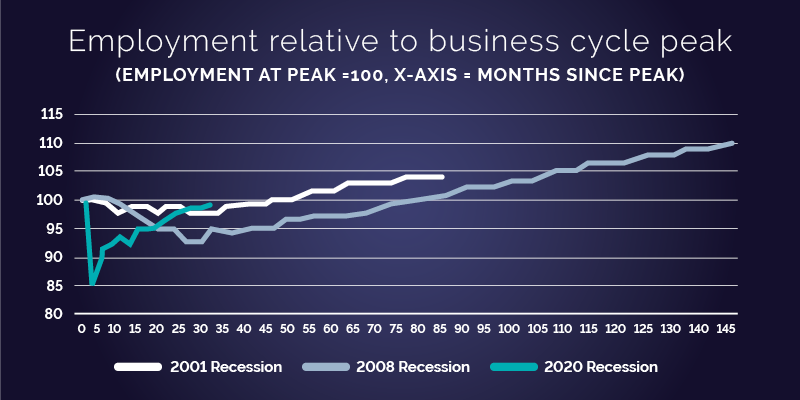
While broad-based job growth has led to a recovery of jobs in nearly all sectors, some have grown more quickly than others and now have employment levels that exceed their pre-pandemic levels. The sectors with the fastest recoveries are linked to industrial production and consumer spending on goods, particularly e-commerce. Whereas sectors that became higher risk during the pandemic due to their in-person work requirements and often lower wages have not fully recovered. Additionally, the speed of this recovery, combined with shifts in consumer spending, may have positive ramifications for certain groups of workers. For example, Black male employment well-exceeds its pre-pandemic level – and has done so for several months. This did not happen in the last economic recovery.
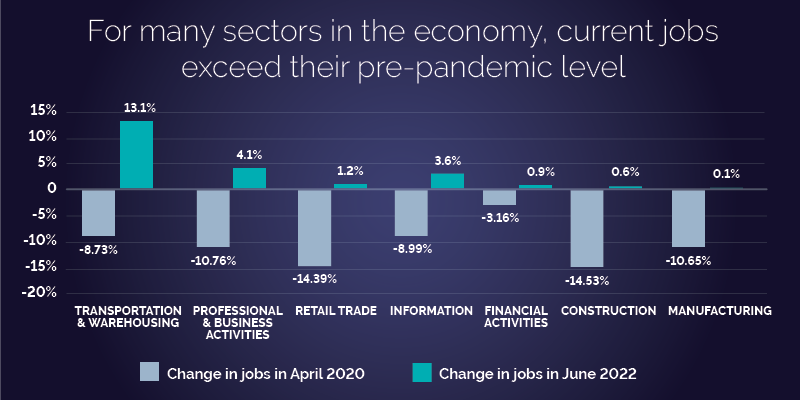
However, even sectors that have not fully recovered are benefiting from this broad-based jobs recovery. For example, leisure and hospitality are still about 1.3 million jobs short of its pre-pandemic level. However, it lost nearly half of its workforce in the pandemic recession and has since recovered almost 7 million workers. It is also possible that a sectoral shift in the composition of the U.S. workforce is taking place, driven by changing risks to in-person work, longer-term changes in consumer spending on services and changing business models such as more at-home work and automation.
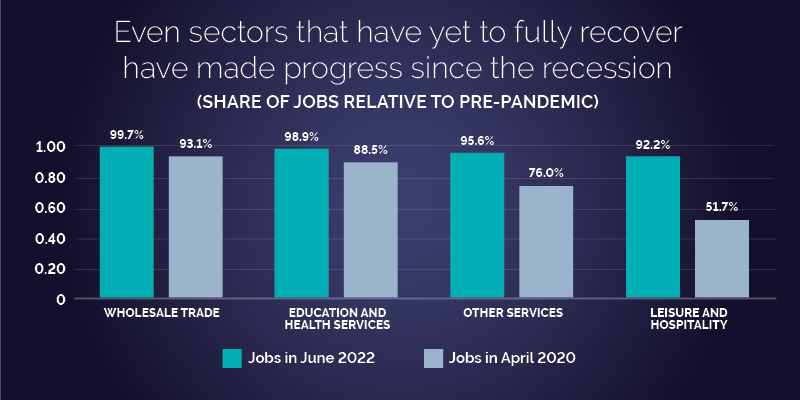
On the whole, the second quarter of 2022 saw a continuation of a strong labor market recovery under the Biden-Harris administration. The monthly payroll numbers (aka the 372,000 jobs added in June) are a reliable coincident indicator for the health of the overall economy. Additionally, two commonly used leading indicators for the strength of the labor market are Unemployment Insurance claims and the duration of unemployment. While initial UI claims have ticked up over the last few months, they are still very low. And, the second quarter averages for the number of persons unemployed for 5 weeks (2.18 million) and for 5-14 weeks (1.64 million) were below their first quarter averages (2.28 million and 1.69 million). The average number of laid off workers in the second quarter of 2022 was also lower than the average for the first quarter. Additionally, the number of unemployed persons who permanently lost their jobs fell to 1.3 million in June 2022, the lowest level since October 2019. That figure peaked at nearly 3.7 million in October 2020.
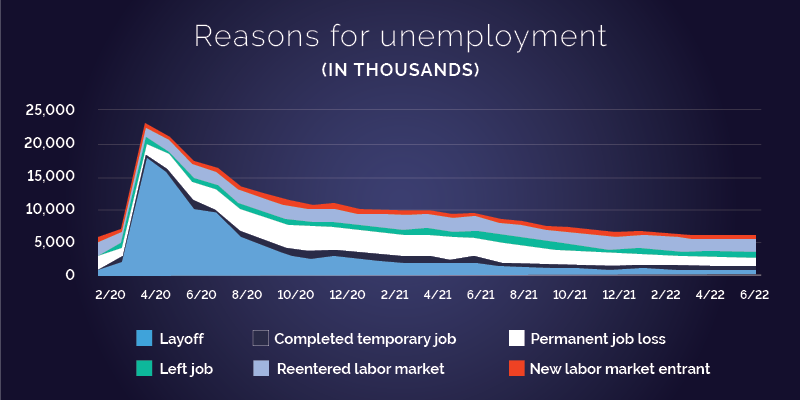
An economy where businesses want to hire
The jobs recovery has been characterized not only by fast job growth, but by a quick recovery in employer demand for workers. However, the pandemic has likely led to some irregularities in the labor market that could explain the broader narrative around employers’ ability to find workers for open positions.
The Beveridge curve (see chart), shows the well-established statistical relationship between the job opening rate and unemployment rate. During the pandemic, it shifted outward, meaning there was a higher number of vacancies for each unemployment rate, even when the unemployment rate was very high. Overall, job matching in the labor market has been less efficient. This could be due to long-running trends in the cost of posting job openings. It could also be due to the speed of the recovery, with employers responding to consumer demand with demand for labor at a faster rate than the labor supply could adjust. Another contributing factor could be sectoral shifts resulting from a change in worker preferences, as mentioned above.
For example, there was less demand for in-person, high-risk work due to the heightened risk of infection and death from COVID-19. In May 2022, the latest data available, in-person, service sector jobs had some of the highest job opening levels, as they are some of the largest industries in the economy. Of the 10.6 million May private sector job openings, 1 million were in retail trade, about 2 million were in health care and social assistance services, and 1.3 million were in accommodation and food services. Job openings in accommodation and food services, a sector with high exposure risk and low wages, have risen incredibly fast, compared to other sectors since the pandemic recession.
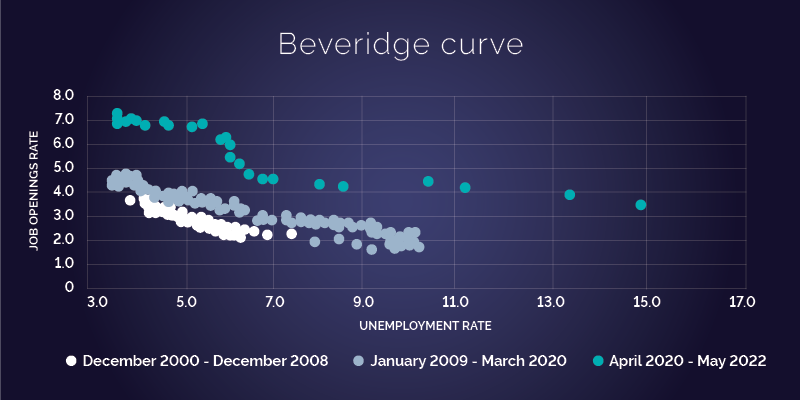
While total job openings remain very high, in the second quarter of 2022, total openings fell for two consecutive months for the first time since the pandemic recession. These changes were statistically significant, though subject to revision by the Bureau of Labor Statistics as more employer data is received. Churn in the labor market – hires plus quits – has been high in the recovery, a sign of a fluid, healthy labor market (though it has declined slightly over the last two months). Additionally, the fill rate – the ratio of hirings to openings – increased from April (0.56) to May (0.58), suggesting that employers had a slightly easier time hiring workers.
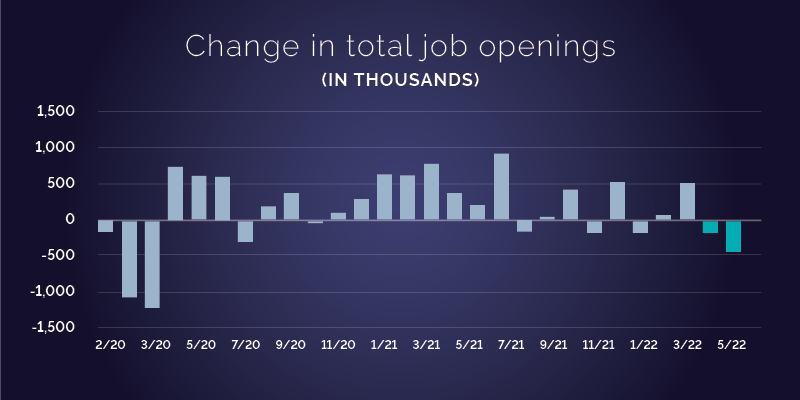
A recovery with more choices for workers
Today’s labor market has given workers more choice in the labor market. With fast job growth, low unemployment (3.6%, the “U-3” rate) and high employer demand, more historically marginalized workers have more opportunities for better jobs. For example, the labor market is very tight for workers without a college degree, possibly leading to some wage compression. The median increase in the non-white worker wage has been consistently faster than the median white worker. And, “U-6”, an unemployment measure that includes Americans working part-time for economic reasons fell to a series low (6.7%) in June. That decline was largely due to a fall in involuntary part-time work.
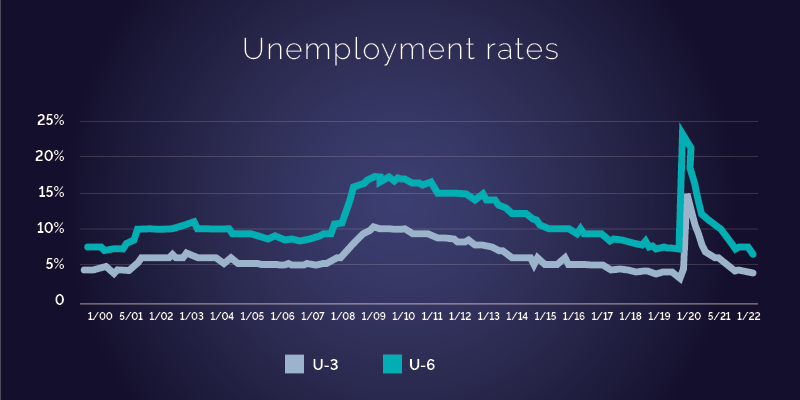
While the unemployment rate has remained low for several months, there is still room to run in the labor market. Labor force participation has risen slowly since the pandemic recession but has not yet return to trend. However, it is worth noting that the pandemic may be changing that trend. Long-COVID, early retirements, a heightened need for care services and other changing family dynamics may have longer term effects on labor force participation.
The tight labor market has increased bargaining power for workers, particularly younger and less-educated workers who are switching jobs or returning to the labor force in jobs at different employers or in different industries. There is a wage premium for switching jobs (see chart). Additionally, for workers staying at their current job, there appears to be heightened interest in forming a union. The National Labor Relations Board recently reported that union representation petitions with the Board were up 56% in the first three quarters of Fiscal Year 2022, relative to the same period in Fiscal Year 2021.
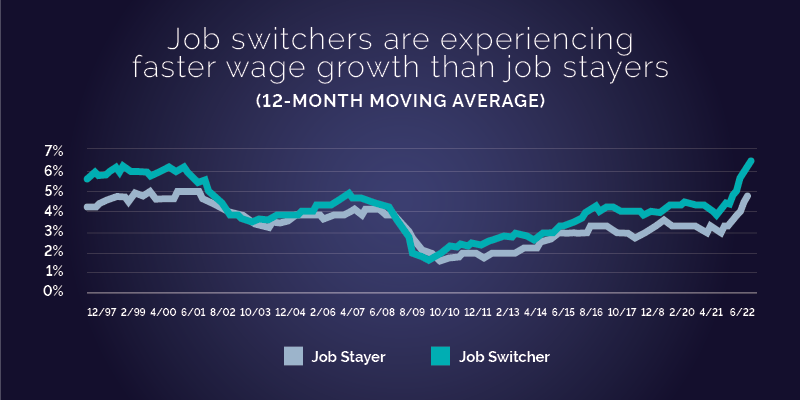
The strength of this labor market recovery still points to the important work ahead to advance an economic policy agenda that is equitable and pro-worker. Rising prices are eroding the purchasing power for workers, increasing the urgency of bringing down costs and increasing the productive capacity of the economy. President Biden’s agenda can help reach this goal, from investments in clean energy to reducing pocketbook costs like prescription drugs and childcare. Additionally, the Department of Labor believes that having a job is important but getting a good, quality job is necessary for Americans workers to succeed. Through our Good Jobs Initiative, we are working to provide critical information to workers, employers and the government to help improve job quality and create access to good jobs free from discrimination and harassment for all working people.
Joelle Gamble is the chief economist for the U.S. Department of Labor.

 U.S. Department of Labor Blog
U.S. Department of Labor Blog